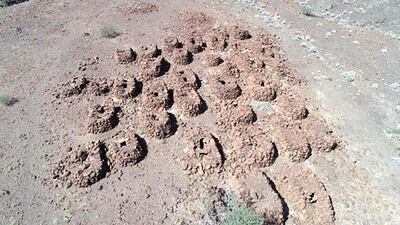Archaeologists discovered an Iron Age settlement and burial site with 45 tombs in Oman’s Al Sharqiyah governorate.
Oman’s Ministry of Heritage and Culture, working with Germany’s Heidelberg University on a project to study Iron Age settlements in North Al Sharqiyah found the new site in Al Mudhaibi. The ministry said the tombs are “very well preserved” and cover a 50 to 80-square metre area.
The tombs are 700 metres from a settlement that the team believes dates from the beginning of the Iron Age and may have been home to people who worked in copper mining.
It is believed there was copper mining at the site during the Iron Age and continued until early in the Islamic era.
“It is the most preserved sites of its components, where stone buildings and tombs resembling huts are retained by nature for more than 3,000 years, and reflect the method of burial,” the Ministry of Heritage and Culture said.
“It features the social status of the deceased through the length of the tomb and archaeological artefacts buried with him.”
Al Sharqiyah site is one of many archaeological finds discovered in Oman over the past decade. Many were discovered by a team from the archaeology department at Sultan Qaboos University, which works with the Ministry of Heritage and Culture to find, protect and preserve sites of interest.
Oman’s ancient sites have also been recognised by the UN. In 1988, Bat, Al Khutm and Al Ayn were certified as World Heritage Sites. The three ancient settlements in Al Dhahira Governorate of north-west Oman are the most complete of their kind from the Iron Age.
In January 2018, the largest trove of Iron Age weapons in the region was discovered at Mudhmar East. It contained more than 3,000 arrows, daggers and axes.


